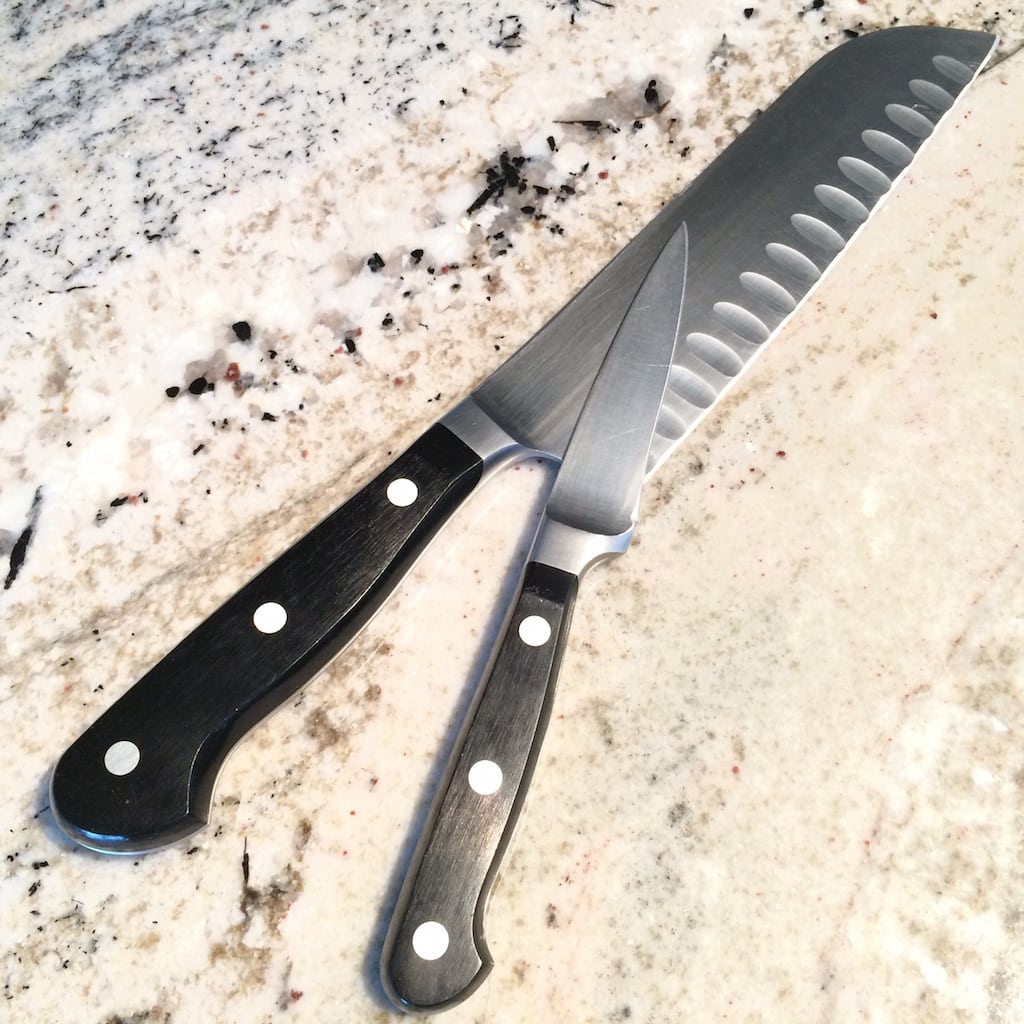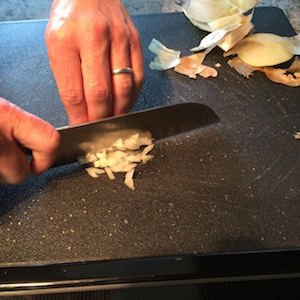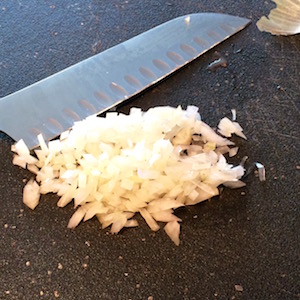Today, I have a great guest post from Doug, at The Kitchen Professor! I have been trying to teach myself better knife skills, and this post is really helpful as I hone those skills. I hope you get as much out of it as I did! I’ll turn it over to Doug, but first, here’s his bio:
Doug blogs at The Kitchen Professor and while his degree is honorary (bestowed upon him by his wife), he has enjoyed cooking his whole life, and especially likes the science of cooking. He loves to cook on cast iron, barbecuing, grilling (especially with a smoker), and loves adding the small, special touch to a recipe that takes it from just “okay” to “wow.”
————————————————————————————–
You wouldn’t decide you wanted to be a runner, and then head out to run a marathon without training, would you? Of course not – you would research training schedules, buy the right running shoes and equipment, and maybe even join a running group so you had moral support.
Cooking is a skill that takes practice, just like anything else. You certainly could try to make an elaborate four course dinner for your friends, and you probably would “finish” (just like limping over that marathon finish line without training), but it most likely wouldn’t be an overwhelming success.
Becoming a great cook takes practice and skills, and mastering certain skills will help increase your success when trying new recipes.
So where should you start?
A great place to start is by learning knife skills, because just about every recipe you encounter will probably involve some cutting during the “food prep” stage. The prerequisite is to have a couple of sharp knives, like a paring and chef’s knife. If you are like me, then you probably need to make sure that your knives are sharp. (Learn more about knife sharpening and sharpeners here.)
With that in mind, let’s review 8 of the standard knife cuts with which you should become familiar. Remember, practice makes perfect, so grab your favorite snack food (I’m always partial to veggies that I can dip into hummus) and start practicing! I was inspired by the “Sharp Things” chapter in the Alton Brown book, Gear For Your Kitchen. Alton is an idol of mine since he gets into the science of cooking which I really enjoy.
Often recipes will call for you to cut your food into cubes. The first four cuts below focus on the terms for cube-type of cuts, going from largest to smallest.
Chop – cut into rough chunks (no standard shape)
Think about the bite size pieces that you would want in a stew, or maybe even the size of watermelon pieces you would want in the summertime. Sometimes if I am making a hearty stew, I allow my chunks to be quite large since they need to hold up to a long cooking time.
Dice – to cut into cubes – usually around 1/4 – 3/4 inch.
If the recipe doesn’t say “large” dice or “small dice,” it would probably be a good idea to shoot for the middle range, around ½ inch. You’ve probably seen “diced” a lot with reference to tomatoes. I dice things more than any of the other cuts since it cooks fast, and we are all shorter on time than we want.
Brunoise – a specific and smaller dice, usually around 1/8 of an inch.
Do you know the julienne cut (see below)? You can julienne the food first, and then finish the food into a bruinoise cut. The bruinoise cut is often used for garnishes.
Mince – rough chunks, like the chop cut, but much finer (even smaller than a bruinoise).
You will often read to “mince garlic” in recipes. Also, the smaller the cut, the more “flavor” it will add to your dish, so you can take some license with recipes if you don’t want (for example) an especially strong garlic flavor.
These next four terms sound fancy, but once you know what they mean you will realize they aren’t intimidating at all. You will definitely run across these terms if you use any French cookbooks!
Lyonnaise – Vertically sliced slivers, usually onions.
The terms “lyonnaise” comes from the region of Lyons, France, and is usually used in reference to onions. It means to cut off the stem and to slice vertically into slivers. Most likely you will only see this in a French cookbook or used in conversation by a chef. Most normal folks will just say, “Vertically sliced onions.”
Julienne – Little skinny sticks.
Also called the “matchstick” cut, involves cutting the food into thin strips, 1 – 2 inches long and 1/8 inch square (think carrot sticks, or really any of those veggies like peppers that I might want to dip into my hummus). These look great when all the veggies are very uninformed and the same size and shape.
Chiffoande – Ribbons, strips of leafy veggies.
This type of cut is used for “leafy” types of food, like lettuce or herbs (especially basil). Simply stack the leaves, roll them up, and slice perpendicular to the roll and you will be left with thin strips. Like the brunoise cut, you can use this for garnishes – I do this most often with basil. You can put the basil on pizza, tomato soup, or fresh cut tomatoes.
Roll – Angular shaped chunks.
The purpose of a roll cut is to have non-parallel surfaces on the cut ends. This may be Chinese in origin, and is used for long vegetables like eggplants, zucchini or carrots. The roll cut adds a visually interesting appearance, but also exposes more of the vegetable’s surface area to heat (for faster cooking) by cutting at a 45 degree angle.
After you cut at the 45 degree angle, you “roll” the vegetable before cutting again. It is much easier to see in a video.
Conclusion and Helpful Links
When it comes to knife skills, practice makes perfect. Get some carrots, onions, tomatoes, potatoes, and anything else that strikes your fancy!
Make sure you have a couple very sharp knives to work with so you don’t pick up any bad habits.
You basically only need a chef’s knife and a paring knife 90% of the time. Start with a 1 or 2 of the cuts above and practice for about 10 minutes a day for a week.
Then, move on to other cuts after you feel comfortable.
More on Knife Maintenance and Knife Sets
More Info on Knife Skills
————————————————————————————–






Hey Kaitlin, Thanks for letting me share some knife maintenance info!
If anyone has any questions, let me know.
Doug recently posted..Chicago Cutlery Magnetic Knife Storage Strip Review
This is the only website I subscribe too, period.
Where do you cook in Atlanta besides home?
I only knew chop, dice and mince. Now i know how culinary cuts are called.
That’s really wonderful article that I personally appreciate. I have already bookmarked it for my wife. Thanks a lot for your valuable info.
Yet another great post, Doug! I have to admit my knowledge about different knife cuts is quite limited, but this write-up has definitely provided some insight. I’ll have to try some of these out soon!
PS: Am I the only one who loves the way “Julienne” sounds? 🙂
Eve recently posted..Electric Sharpeners You Should Definitely Consider (2017 Guide)
thank you for the information about knives
jenny recently posted..BEST KNIFE SET UNDER 200 | 10 BEST KITCHEN KNIFE SET UNDER 200 REVIEWS
Chef knife is very famous to real chef and house wife’s. It is very important that your knives are kept in good condition.
There are specialist chef knives available that are particularly suited to chopping vegetables, meat, fishes, herbs and small fruits; although bigger fruits such as watermelons, pineapple require bigger knives for safety purposes. You can use chef knife undoubtedly to your restaurant and house.
It’s wonderful! Articles, Amazing!
Really love to read this post and its seems like a great blog i have ever seen. Just read your article.
Good one. I liked it. Keep going. you are a best writer your site is very useful and informative thanks for sharing!
Which knife is best for vegetables?
Great article, very informative. I had no idea Dough own a kitchen blog.
It’s really awesome collection. Thanks for sharing this list.
Thank you for your time to research and share it with us. I appreciate the quality of the article.
Melissa recently posted..Best Steak Knives Consumer Reports, America’s Test Kitchen
Community engagement https://bdboostingservice.com/ is necessary to achieve successful advertising on Facebook. Increasing page like is needed to build brand awareness and deliver ROI. For that you will need quality Facebook likes. We are here to offer you the quality and quantity of page likes. We will attract the right audience and engage them in ways that align to your business goals. We will make sure that your brand’s images and description are engaging and encourages people to like your page.
I have read entire article and this is really amazing. I have learnt many things from your article.
Thank you for the list of must-have knives. This is quite useful as I begin to put together a set of high-quality knives and become more efficient in the kitchen. The quality of the knife makes a significant impact, not only in terms of efficiency, but also in terms of improving the enjoyment of cooking. This is an excellent website!
Good Post. It depends on how many knives I want and also Which knife is good for a gift. You are clear on this post. Thanks. But if you want to know more about knife set or budget knife set you can go here-
https://kitchenskit.com/best-knife-block-set-under-200/
“Doug’s knife skills guide is a game-changer! I appreciate the breakdown of cuts and practical tips. Perfect for honing my cooking skills. Thanks!”
I’ve used it for everything from slicing tomatoes to light whittling, and it’s performed flawlessly. The [Blade Shape] is perfect for my needs, and the overall balance of the knife is spot on. The [Sheath Material] sheath is also well-made and provides a snug fit. Honestly, for the price, this knife is an absolute steal. If you’re looking for a reliable and versatile knife.
This is very helpful, as I start to slowly put a set together of high quality knives and become more effective in the kitchen .Thank you for sharing this knife list. It is so great.
A high-quality sharp kitchen knife is a vital tool in any kitchen. Undoubtedly, a reliable knife simplifies tasks and enhances comfort while cooking. I truly value your insightful discussion on this topic. Thank you very much.
Now i know how many knife daily use. Thank you.
This post is such a gem—thank you Doug and The Kitchen Professor! 🙌 Learning proper knife skills truly is a game-changer in the kitchen, and I love how this breaks it all down into approachable steps. The comparisons to running and training really hit home—it’s so true that cooking takes practice. I especially appreciate the clarification between dice, brunoise, and mince. Definitely bookmarking this for future reference (and maybe printing it out for the fridge!). Thanks again for the helpful and down-to-earth tips!
The suggestion to start with knife skills is very practical though almost all cooking needs cutting and prepping ingredients. So, knife is very important.
Wow! this knife set is amazing and this is very helpful, as I start to slowly put a set together of high quality knives and become more effective in the kitchen .Thank you for sharing this knife list. It is so great.